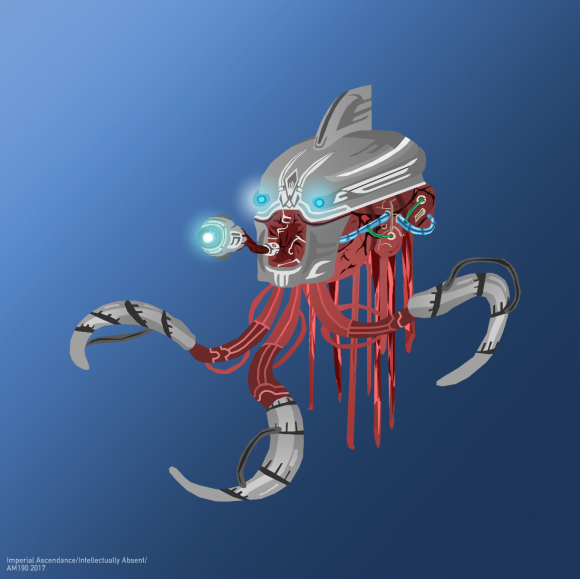BY LETTER
Trias Vecs
Galactography > Other Major Polities, Empires, and Meta-Empires > Archosaurian Empire
Sophonts > Modosophonts > Vec
Sophonts > Modosophonts > Vec
Vec clade from the Archosaurian Empire region | |
 Image from IA190 | |
| Trias vecs are amphibious, and spend much of their time in water | |
Over the course of several decades the trio collaborated on a number of projects within their home hab, winning several awards for their work on water park design. Memory records from Sarainolopolass indicate that the friendship began to become romantic through PlaceDancer who would adopt aesthetically pleasing and sexually compatible forms for both her and Forlorn 2/3 separately. As part of er life philosophy PlaceDancer would regularly edit their mind to adapt their sexual preferences as needed to match that of their partner. E passed on this habit to the other pair who began to experiment with tweaking themselves for each other also. The process was slow and tentative, not least due to the overall cautious culture of their hab regarding direct mental/psychological modification. Eventually they reached a stage of deep, romantic love for each other that began to shine through in their artistic work. In 7690AT they created a series of water parks with private domicile areas for themselves, creating a home together. At this point Sarainolopolass began adopting bodymods to enable her to live on land, for a time, without the assistance of an envirosuit. These changes would ultimately lead to the creation of the Trias clade as it introduced the practice of the trio physically adapting to facilitate their relationship. PlaceDancer moved away from modular design and bought their varied experiences to the project. Again the pace of change was slow with the three gradually changing by iteration until they converged on a common form that they could all love to be, love to be with and use whilst carrying out their ecological design work. The resulting clade bodyform they named 'The Trias Template' and released it to the Known Net in 7735AT.
Variants of the design have been created over the centuries but the original version is bilaterally symmetrical and amphibious, consisting of a central body with hard exoskeleton, fixed sensors as well as sensor stalks for higher resolutions, three large tentacle limbs and a biological 'underbelly'. This spongey tissue is generally formed into a plethora of organic tentacles of varying sizes; some popular clade variants have a similar layer growing on the surface of their main tentacles, sensor stalks and even body ridges.
Some taxonomists class the Triasians as cyborgs, because of this layer of biological tissue. However the clade does not self-identify as cyborgs since the tissue does not play a role in the maintenance of the main body. If it is shed or removed for any reason no real loss in functionality will occur; instead the underbelly is considered to be part decoration, part tool.
The original triad included the feature to aid in their ecosystem design work. The tissue itself is highly programmable, designed to easily accept new genetic sequences synthesised by components within the body. This allows the underbelly to be used to grow and release spores, seeds and eggs for a wide range of species, as well as act as a plant bed in order to feed various aquatic species. Consequently the Trias clade is popular among aquatic ecosystem engineers who will use it to directly cultivate their environment. Triasians who do not subscribe to that vocation still often retain their underbelly but use it to grow decorative (or even recreational) plant beds.
Psychologically Triassians are highly social and are classed as empai (albeit at the lower end of the enhanced-EQ scale). They tend to form extended networks of communes and maintain high numbers of friendships. Long term romantic relationships are common with cognitive pathways that strongly reinforce positive romantic relationships with up to two individuals. Whilst the Trias bodyplan contains no internal wombforge component, newly fabricated Triassians are granted underbelly transplants from their parents, providing a sense of bodily continuity. The original design for the clade included pathways that would result in individuals becoming more attracted to those their partner finds attractive, thus converging most relationships towards trinogamy. Many variants have altered these predispositions in some way; from altering the strength of the predisposition to the specific group relationship number, but across the Trias clade polygamous relationships are the norm.
It is currently estimated that the Trias population is nine hundred million within Nexus-connected systems. This number has been in slow decline over the last few centuries as the clade has lost some popularity. However few commentators are concerned as historically the clade's numbers have ebbed and flow depending on trends in aquatic ecosystem fashion.
Related Articles
- Environmental Engineering - Text by M. Alan Kazlev, from the original by Robert J. Hall
Ensuring environments remain favourable to bionts. Includes both environmental protection (pollution control, waste recycling or treatment) and habitat biosphere optimization, biont hygiene and health issues and standards, and biosphere engineering in general (biospherics). - Environmental Vecs
Appears in Topics
Development Notes
Text by Ryan B
Initially published on 15 July 2017.
Initially published on 15 July 2017.






